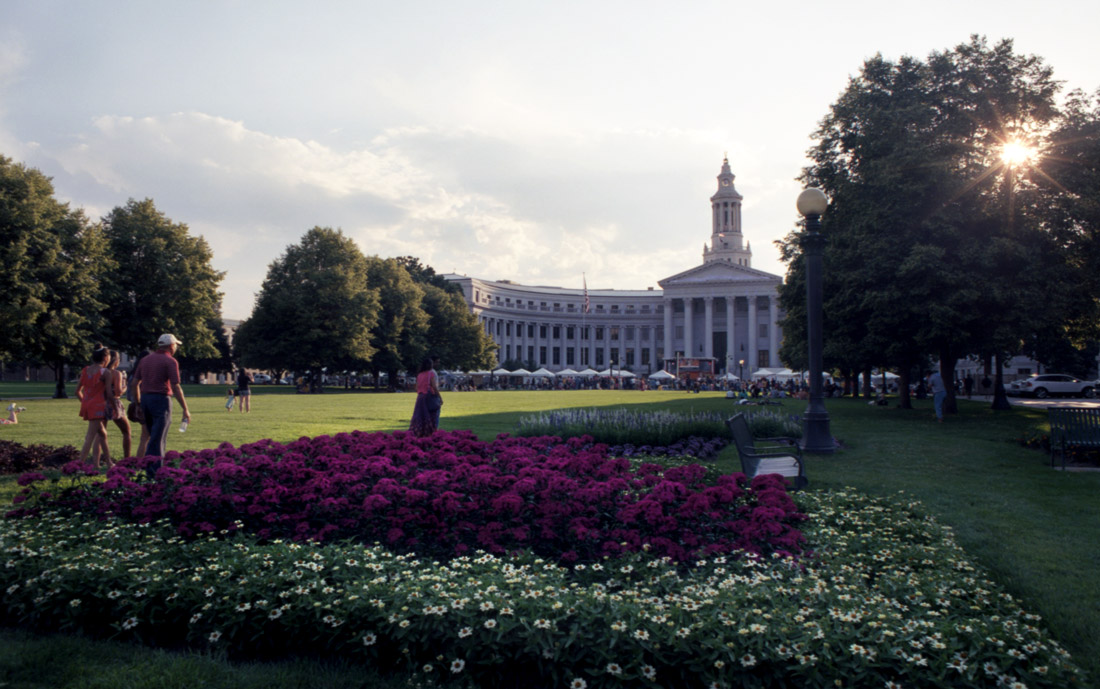
Photowalking has become a pretty big business in the last decade or so, as semi-professional digital camera prices have come within reach of more and more people.
It seems that they also satisfy the oft-repeated advice to get out there and take pictures. Frequently this is the advice touted as most important when someone is getting started, and certainly it’s very important. As with any craft, the only way to improve is to practice, practice, practice.
And when you get the photographer’s equivalent of writer’s block (shooter’s block? lensman’s block? Monday?), a photo walk can be one way to re-start that creative engine by immersing yourself in new surroundings or by getting a different perspective on a place you know.
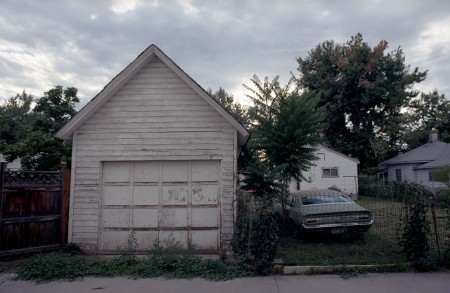
But of course there’s a lot more to it than just pressing the shutter release. You can certainly work on “seeing differently” on a photo walk, and definitely use it as an excuse to “just shoot everything.” These types of advice work great in the digital world, but they can get expensive if you’re a film photographer.
At this point I’m still pretty happy when more than 25% of what I shoot yields good negatives I wouldn’t be embarrassed to print or scan and subsequently show to someone. With the price of film and developing (which is pennies if you do it yourself), that still winds up costing me a buck a frame with 35mm film. It can go up to $2-3 a frame with medium format. Double those figures for color negative film, and triple them for chromes.
So I’m not terribly sure a photo walk is always the best idea.
Now, I actually do it pretty often on my own. A lot of my camera testing is done by way of solo photo walks on 16th Street Mall, or in Capitol Hill or another of Denver’s historic districts or neighbohoods. I’ve only participated in a few group photo walks ever, though, and they’ve left me with mixed feelings.
So that’s what I was talking about above, really — group photo walks. They can go well or badly, and can help or hurt you. Especially if you shoot film.
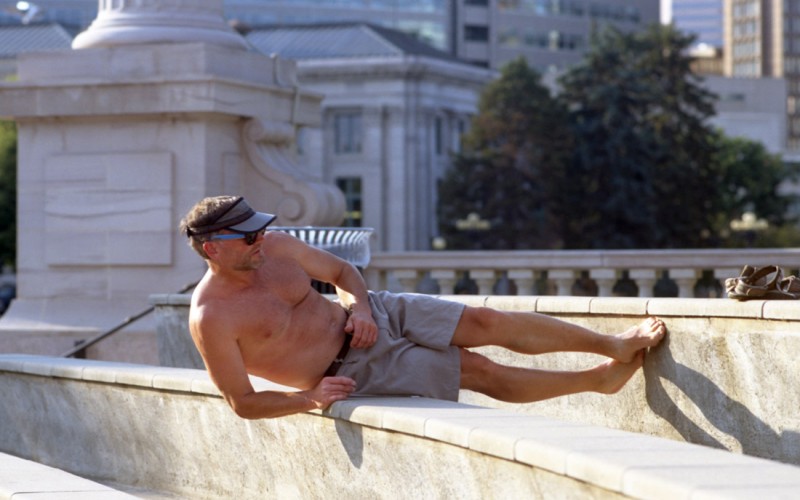
Large group
I think the first group photo walk I ever went on was when Trey Ratcliff led a walk in Denver last summer. Ratcliff is a noted travel photographer, educator and frequent photo walk leader. In fact, he’s doing a big photo walk tour of the U.S. right now.
I heard about the walk via Twitter and had no other plans that night. I’d never heard of Ratcliff prior to that day. I had no idea what it would be like. It wasn’t hard to find, though — the crowd was sizable.
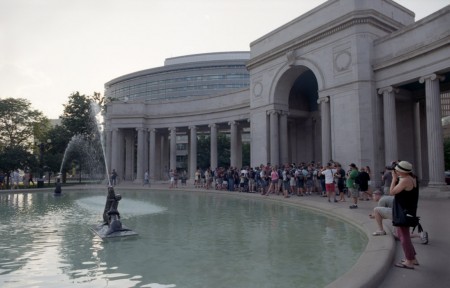
Ratcliff has really taken to digital photography (I don’t know if or how long he used film before switching) and his work is colorful and seems, to me, to lean heavily on the types of minor manipulation that Photoshop and Lightroom, and other software, have made so easy today.
Of course, I was the only person there shooting film — which I’m used to. A lot of people asked me about it. I felt a little mobbed a couple times, but the attention was good attention — very positive energy, etc.
Ratcliff planned a simple route around the Denver Art Museum, through Civic Center Park and back down Bannock Street through the Golden Triangle. All this ground is pretty familiar to me, so I didn’t feel terribly inspired by the scenery, but did find some things to photograph and maybe learned a couple things.
The group was big — probably too big — which presented communication challenges for Ratcliff, and a variety of other minor complications. Everyone seemed very happy to b there, though.
One of the things most memorable for me was helping out other photographers. One novice who’d gotten a new-to-him DSLR couldn’t figure out the menu system to adjust white balance settings, file quality, etc. Working together with another couple photographers, we managed to jointly figure most of it out.
Later, a young woman came to me with questions about the exposure triangle. She’d never used anything but program mode and had overheard me talking about aperture priority and shooting all manual (I had taken my Nikon FM2 kit and had no automatic exposure). We had a good conversation and I saw her have that “A-ha!” moment where it all clicked. I felt really good about that.

Small group
Last fall, a few followers of the Twitter hashtag #believeinfilm, myself included, met up in Denver’s West Highland neighborhood for a bit of a photo walk. There were only four of us, though, which was very manageable and made it much more a social outing.

I suppose that’s what a group photo walk should be, really — a social outing. If your goal is to meet other photographers, you probably can’t go wrong with a group photo walk.
Heck, that little film photo walk was where I met @shootfilmride, and later led to the aircraft salvage yard where we both met Craig Pindell, and ultimately to the collaboration the three of us are working on now.
Another thing I have decided I like about group photo walks is the ability to see other photographers working. Sure, I can look at their photos of things I know and try to reconstruct where they stood and why they shot from high or low, etc. But watching them choose their subject and figure out how they want to shoot it seems more instructive and can be inspirational.

Without further ado, here are my lists of the good and the bad in regard to group photo walks:
The good
These are my personal top reasons why a group photo walk might be a good thing for you, based in part on JPGmag’s top 10 list and Scott Jarvie’s article on organizing a successful group photo walk.

- Socialization. Photographers are often a solitary bunch — we’re in our darkrooms or glued to Photoshop or whatever — so a scheduled activity that will bring out a lot of them at once may be among your only opportunities to meet many of them in person and share tips and tricks.
- Synergy. This was suggested by my editor, and he’s right — I left it out. “Synergy” is the word he suggested to describe the “whole is greater than the sum of its parts” aspect of shared knowledge made possible by a group in which you have the opportunity to both ask questions of more-experienced photographers, and answer them for less-experienced photographers. In a group, you may even be able to synthesize different answers or tips from a number of other photographers.
- Branching out. Some group photo walks have a theme such as street, landscape, fashion, or whatever. These might be a way to introduce yourself to a type of photography you haven’t tried before and would like to. Or, even just try something new that you never considered. You may also get to know a place you always wanted to see, or had never even heard of.
- Boning up. Rather than trying something new, some photo walks might help you hone skills you’re already working on, such as those that focus on portraiture or using artificial lighting. You might be expanding these skills simply through practice, but sometimes you may have the opportunity to walk with an expert who can explain their process and techniques, and whose brain you can pick.
- Access. This can mean access to people, places, or resources. Some group photo walks will take care of location permissions and allow you to make pictures someplace that would otherwise have been difficult or impossible for you to get into. Or they may hire a couple of models for people to work with. Some will allow you to try out new gear or use gear that would be outside your financial reach, too — especially when the event is sponsored by a manufacturer.
- Pressure. Agreeing to participate in an event might convince you to go out even though you don’t feel like it — it’s harder to say the heck with it when others are expecting you. More than that, having a pre-arranged time might encourage you to shoot when you’ve been feeling uninspired. Competitiveness, too, seems natural among photographers and it’s not necessarily a bad thing — especially if it’s a friendly competition.
- Safety. Being in a group will tend to get a bit of herd immunity working, which will both make you all less appealing targets for thieves and give you a lot more eyes to watch for signs of trouble.
- Feel-good factor. This one comes from exposure to other photographers. You’re going to have questions, especially when you see other photographers working in ways you don’t recognize or hadn’t considered. This is a perfect time to get the answers and go home feeling a little bit smarter. Moreover, no matter how much of a beginner you think you are, the odds are good there will be someone else who’s a bigger newbie. When they have questions, you have an opportunity to help them out. Now they go home with new knowledge and you go home realizing you’re less of a noob than you thought you were. Either way, you feel good!

The Bad
These are based on my own experiences. I looked for articles about others’ negative group photo walk experiences and came up empty, so these may be better thought of as things to watch out for.
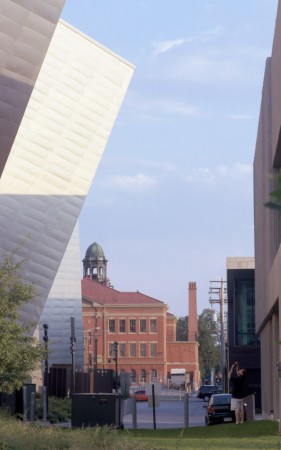
- Large groups. If you suffer any kind of social anxiety disorder, or are strongly misanthropic, you may have trouble with large group photo walks. Photo walks with well-known photographers, especially in these heady days of invites spreading like wildfire on social media and decent cameras available for just a couple hundred bucks, may attract dozens or even hundreds of people. It’s okay to stay on the fringes of the group if you’re uncomfortable, or keep looking and find less-well known group leaders to check out, etc.
- Large groups. This is the flip side — a large group of people carrying DSLRs and long lenses, and maybe tripods and strobes, can be intimidating. You might attract the attention of security guards or police, and you may create roadblocks for other pedestrians or even cars. Be aware of the ways a group could be intimidating or meddlesome for those who aren’t a part of it and do whatever you can to minimize your impact on the natives.
- Lost in the shuffle. While it’s possible to get separated from the group, the real trouble is the level of activity. It may be too distracting for you to feel productive, and the social demands may infringe on the photography or vice versa. “The balancing of taking pictures with meeting people is an art and it takes a a little experience to find it,” Jarvie says. And he’s right. You may enjoy more success if you start off trying to focus on just one or the other.
- Pressure. If everyone in front of you is lining up to take a picture of certain tree or building facade when the light is just right, you might feel pressure to join in. Maybe you didn’t think it was a good picture to make, but the group leader made one and then everyone else started making the same picture, too. Don’t sweat it — your photography is all about your vision, and if your first instinct is that there’s no photo there — and then you feel pressured and reconsider, but still think there’s no photo there — you’re probably right. If you don’t think it’s worth shooting, it’s probably not worth shooting for you. So don’t.
- Format wars. At this point, if you’re the one person shooting film among dozens or hundreds of people with digital cameras, it’s possible the attention they’ll give you (and your ancient and confusing hardware and the wizardry it clearly requires) could be so distracting that it becomes burdensome and annoying. I’ve had zero luck finding film photography photo walks to try out aside from a few mutually-arranged meetings with Twitter friends. Your results may vary, but it’s at least worth Googling.
I guess it’s obvious now that a lot of the pros can easily become cons, and that a lot of the value and enjoyment of a group photo walk is up to you to discern.

How to not suck at photo walks (with film)
Most of this advice is format agnostic, but I’m adapting it for film a bit. Loosely based on DPS’ 10 Tips for Enjoying a Photo Walk.
Pretty much all of this advice applies to solo photowalking as well as group photo walks.

- Attitude. Be sure you bring an open mind with you or you’ll get nothing from the experience. Also, if you’re grouchy or negative, people will notice (trust me, I have first-hand experience being that guy). Help others of lower skill levels feel welcome and be prepared to do more networking than shooting — it happens and it’s totally okay.
- Be a regular. If you aren’t immediately turned off by your first couple of group photo walks, most people seem to agree that showing up to the same ones regularly will help you the most by strengthening your connections with other regulars, and by putting you on more familiar ground after your first few, which should help you balance your shooting with your gabbing.
- Everything in moderation. Don’t bring a big bag loaded with lenses and bodies if you can help it. Of course, with film you’re limited to the same film for the whole roll, so maybe you want a second body for black and white film, or high-speed film, or whatever. I get that. If possible, take bodies that can share the same couple of lenses, though. Your back will thank you if you keep your load light.
- Go extreme. Take this opportunity to bring a camera you haven’t had much experience with, or force yourself to use only one lens (leave the rest at home!), especially if it’s a focal length you’re trying to get more comfortable with. Do you usually shoot in aperture priority? Take the night off and switch to manual. Or do the reverse — give in to the microchip and let it do some of the work.
- Take backup. Film, that is. And probably batteries. If you’re not prepared to switch to Sunny-16 rules on the fly, you’ll want that meter working (or worse, if your camera’s shutter is electronically controlled and won’t fire with dead batteries). Film, though — this is pretty much critical. If you only bring the half-used roll that’s already in your Holga, you’re really going to regret it. Seriously. Bring plenty of film.

- Bring business cards. If you have them, that is. You’ll have plenty of opportunities to pass them out, and you can use the backs for notes if you forget to bring (or eschew) a Moleskine.
- Pay attention. Don’t lose the group, don’t step into traffic, don’t talk over the group leader … basically don’t be a jerk and don’t get yourself killed by gluing your eye to your camera too securely. While it may be true that the value of your art will increase after you die, you want to live long enough to build up a large supply of unsold work for your heirs or assigns to sell when you’re gone.
- Be prepared. We’re talking Boy Scout-style here. If there’s even a remote chance of rain, or snow, or whatever, be ready for it. Dress in layers and have rain gear ready. You can get rain gear for your camera, too, if you think you’ll need it. Bundle up if it’s cold, and don’t forget your fingerless gloves.
- Hydrate. Bring water. Bring a backpack with a water bladder in it, or replace one or two of the lenses you’re leaving at home with a water bottle or three. I usually figure on about a half liter of water per hour in comfortable weather; more like one liter per hour if it’s going to be much above 75 degrees Fahrenheit and/or in full sun the whole time, or if it’s going to be near or below freezing.
- Footwear. This goes for any time you’re going out on foot with a camera: wear adequate footwear. The more gear you’re carrying, the more important it is to have tough, supportive shoes or boots. I have a pair of tall Keen hiking boots that hold my ankles firmly and support my feet incredibly, and which I wear any time I anticipate more than about 15 minutes at a time on my feet with a full camera bag. I wear a less aggressive hiking shoe such as those from Keen, Teva, Oboz or Merrell the rest of the time. This makes sure I can get traction when I clamber toward the edge of a cliff because I want the valley floor in my ultra-wide shot, and even without the high tops a bit of extra support keeps me from turning my ankles all the time.
- Tell someone. Just like you wouldn’t go hiking without telling someone where you were going and when you expected to return, don’t go photowalking without at least letting someone know. Heck, tell the whole world and let them follow along like Dean Krakel is currently doing on his solo thru-hike of the Colorado Trail.
I hope this discussion helps you decide if a group photo walk is for you, or encourages you to give one a try if you haven’t before. If you’re going to stick with working solo, I don’t blame you one bit. But do try to find some way to get outside your comfort zone now and then.
Be safe and have fun!
